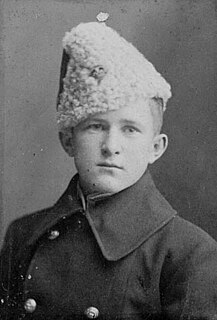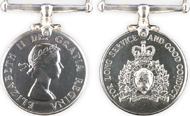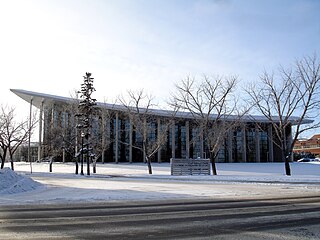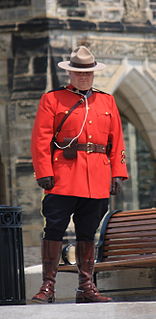 W
WThe Royal Canadian Mounted Police, often known as the Mounties, are the federal and national police service of Canada, providing law enforcement at the federal level. The RCMP also provide provincial policing in eight of Canada's provinces and local policing on a contract basis in the three territories and more than 150 municipalities, 600 Indigenous communities, and three international airports. The RCMP do not provide active provincial or municipal policing in Ontario or Quebec. However, all members of the RCMP have jurisdiction as a peace officer in all provinces and territories of Canada. Despite the name, the Royal Canadian Mounted Police are no longer an actual mounted police service, with horses only being used at ceremonial events.
 W
WThe British Columbia Provincial Police (BCPP) was the provincial police service of British Columbia, Canada, between 1858 and 1950.
 W
WA buffalo coat is a heavy winter garment made from the bison, which also commonly known as the "buffalo". In North America they descended from the simpler, sleeveless buffalo robes worn by the Indigenous peoples of North America prior to their partial replacement by capotes made of point blankets during the North American fur trade. Similar garments were also used across Eurasia prior to the gradual displacement and near-extinction of the European bison or wisent. Commercially produced coats with sleeves and buttons became popular with non-indigenous people during the early settlement period of the American West and the Canadian prairies. Their use mostly ended because of a rising conservationist movement intended to preserve the bison, which had been hunted to near-extinction in North America as well.
 W
WA campaign hat, sometimes called campaign cover, is a broad-brimmed felt or straw hat, with a high crown, pinched symmetrically at the four corners.
 W
WThe Canadian military fur wedge cap, "envelope busby", or colloquially "The Astrakhan" is a uniform hat worn by the Canadian military and RCMP. The outside of the cap is entirely covered in real or synthetic fur and is shaped like a wedge. When not being worn the cap folds flat. The cap is about 8 inches (200 mm) high but is normally worn with the apex of the wedge shape depressed back into the interior of the cap to form a longitudinal trough at the crown, reducing the overall height. Often the cap is patterned such that the front of the crown will be slightly higher than the back. On one side of the military style fur wedge cap hangs a flat flap made of cloth or wool that extends from the crown to the bottom of the cap, known as the "bag". The colour of the "bag" was determined by the regimental colours. The bag is very similar to that worn with the busby. Because of the cap's passing resemblance to the hussar busby author and researcher James J. Boulton dubbed it the envelope busby. Still, whatever influence the busby may have had on its design, the fur wedge cap pattern was "distinctly Canadian."
 W
WThe Royal Canadian Mounted Police (RCMP) has a history dating back to 1873 and has been involved in several high-profile controversies.
 W
WCourage in Red is a 13-part television documentary that details many aspects of crime that the Royal Canadian Mounted Police must contend with on a daily basis. Each 30 minute episode focuses on a certain aspect of the RCMP such as training at the RCMP Academy, Depot Division in Regina, frontline police work, the Emergency Response Team, canine unit, and VIP protection among others.
 W
WOn October 14, 2007, Robert Dziekański —a Polish immigrant to Canada—was killed during an arrest at the Vancouver International Airport in Richmond, British Columbia.
 W
WCanadian Firearms Program, formerly Canada Firearms Centre is a Canadian government program within the Royal Canadian Mounted Police Policing Support Services, responsible for licensing and regulating firearms in Canada.
 W
WThe Highway of Tears is a 725-kilometre (450 mi) corridor of Highway 16 between Prince George and Prince Rupert, British Columbia, Canada, which has been the location of many missing and murdered Indigenous women (MMIW) beginning in 1970. The phrase was coined during a vigil held in Terrace, British Columbia in 1998, by Florence Naziel, who was thinking of the victims' families crying over their loved ones. There is a disproportionately high number of Indigenous women on the list of victims.
 W
WIntegrated Security Unit (ISU) is a joint-services infrastructure security unit created to secure major events in Canada. This administrative and operational entity was first created by the Royal Canadian Mounted Police (RCMP) in 2003.
 W
WThe Royal Canadian Mounted Police Long Service Medal was established by royal warrant on 6 March 1934 by King George V. It is the oldest continually awarded honour within the Canadian honours system, and the first created specifically for Canadian service within Canada. Initially proposed by the Royal North-West Mounted Police Veterans’ Association, it took more than ten years for the proposal to be realized. The determination of the veterans was aided by the interest of Commissioner Cortlandt Starnes and Prime Minister R.B. Bennett.
 W
WThe Mayerthorpe tragedy occurred on March 3, 2005, on the farm of James Roszko, approximately 11 km (6.8 mi) north of Rochfort Bridge near the town of Mayerthorpe in the Canadian province of Alberta.
 W
WThe Moncton shootings were a string of shootings that took place on June 4, 2014, in Moncton, in the Canadian province of New Brunswick. Justin Bourque, a 24-year-old Moncton resident, shot five officers from the Royal Canadian Mounted Police (RCMP), killing three and severely injuring two. A manhunt for Bourque was launched and continued overnight and into June 5. On June 6, Bourque was found and taken into custody, ending a manhunt that lasted over 28 hours. The shooting was both Moncton's first homicide since 2010 and the deadliest attack on the RCMP since the Mayerthorpe tragedy in 2005, which left four RCMP officers dead. Bourque intended for the shootings to trigger a rebellion against the Canadian government.
 W
WThe North-West Mounted Police (NWMP) was a Canadian para-military police force, established in 1873, to maintain order in the new Canadian North-West Territories (NWT) following the 1870 transfer of Rupert’s Land and North-Western Territory to Canada from the Hudson’s Bay Company, the Red River Rebellion and in response to lawlessness, demonstrated by the subsequent Cypress Hills Massacre and fears of United States military intervention. The NWMP combined military, police and judicial functions along similar lines to the Royal Irish Constabulary. A small, mobile police force was chosen to reduce potential for tensions with the United States and First Nations. The NWMP uniforms included red coats deliberately reminiscent of British and Canadian military uniforms.
 W
WThe October Crisis refers to a chain of events that started in October 1970 when members of the Front de libération du Québec (FLQ) kidnapped the provincial Deputy Premier Pierre Laporte and British diplomat James Cross from his Montreal residence. These events saw the Prime Minister Pierre Trudeau invoking the War Measures Act for the first time in Canadian history during peacetime.
 W
WRCMP Academy, Depot Division is the police training academy for Royal Canadian Mounted Police (RCMP) "cadets." Providing training since its establishment in 1885, the facility is located in the west part of Regina, Saskatchewan, near the airport, and consists of several buildings.
 W
WThe Royal Canadian Mounted Police, often known as the Mounties, are the federal and national police service of Canada, providing law enforcement at the federal level. The RCMP also provide provincial policing in eight of Canada's provinces and local policing on a contract basis in the three territories and more than 150 municipalities, 600 Indigenous communities, and three international airports. The RCMP do not provide active provincial or municipal policing in Ontario or Quebec. However, all members of the RCMP have jurisdiction as a peace officer in all provinces and territories of Canada. Despite the name, the Royal Canadian Mounted Police are no longer an actual mounted police service, with horses only being used at ceremonial events.
 W
W"E" Division is the division of the Royal Canadian Mounted Police in the province of British Columbia, Canada's westernmost province. It is the largest police body in the province, providing federal and provincial services throughout the province and policing all but 12 municipalities. In some urban areas, some municipalities have their own police forces while neighbouring ones contract with E Division. For example, Richmond is patrolled by E Division while neighbouring Vancouver has its own police force; both organizations contribute members and resources to various regional initiatives. E Division is the largest RCMP division, with 127 local detachments.
 W
WThe RCMP Heritage Centre is a law enforcement museum located in Regina, Saskatchewan, Canada. The museum houses a number of exhibits on the Royal Canadian Mounted Police (RCMP) and artifacts relating to the police force. The heritage centre's 6,000-square-metre-building (65,000 sq ft) was designed by Nick Milkovich Architects, and is situated in the northeast end of RCMP Academy, Depot Division.
 W
WThe Red Serge refers to the jacket of the dress uniform of the Royal Canadian Mounted Police. It consists of a scarlet British-style military pattern tunic, complete with a high-neck collar and blue breeches with yellow stripe identifying a cavalry history.
 W
WThe Red Wall: A Woman in the RCMP is a non-fiction book, written by Canadian writer Jane Hall, first published in July 2007 by General Store Publishing. In the book, the author chronicles her personal experiences as the first woman accepted in the Royal Canadian Mounted Police (RCMP).
 W
WRough rider was a now defunct rank and appointment used in the British Army, and also in some British colonial forces, by men who were responsible for training horses and teaching equitation under the supervision of the riding master. If used as a rank it was equivalent to private, but non-commissioned officers could use it as an appointment, with designations such as troop sergeant major rough rider. Following its abolition as a rank, it continued to be used as an appointment.
 W
WThe RCMP Foundation was founded in 1994 as a charitable organization. Since 1994, the RCMP Foundation has contributed more than $10.5 million to support some 1,000 community groups initiatives across the country. "About Us".
 W
WRCMPV St. Roch is a Royal Canadian Mounted Police schooner, the first ship to completely circumnavigate North America, and the second vessel to transit the Northwest Passage. She was the first ship to complete the Northwest Passage in the west to east direction, using the same route that Amundsen on the sailing vessel Gjøa had traversed east to west, 38 years earlier.
 W
WUnited States v Burns [2001] 1 S.C.R. 283, 2001 SCC 7, was a decision by the Supreme Court of Canada in which it was found that extradition of individuals to places where they may face the death penalty is a breach of fundamental justice under section 7 of the Canadian Charter of Rights and Freedoms. The decision reached this conclusion through a discussion of evidence regarding the arbitrary nature of execution, although the Court did not go so far as to say execution was also unconstitutional under section 12 of the Charter, which forbids cruel and unusual punishments.
 W
WWood Mountain is a village in the Canadian province of Saskatchewan within the Rural Municipality of Old Post No. 43 and Census Division No. 3. Its name is derived from the Red River Métis words "montagne de bois", due to the abundance of poplar trees in the otherwise barren region. Highway 18 and Highway 358 intersect south of the community.